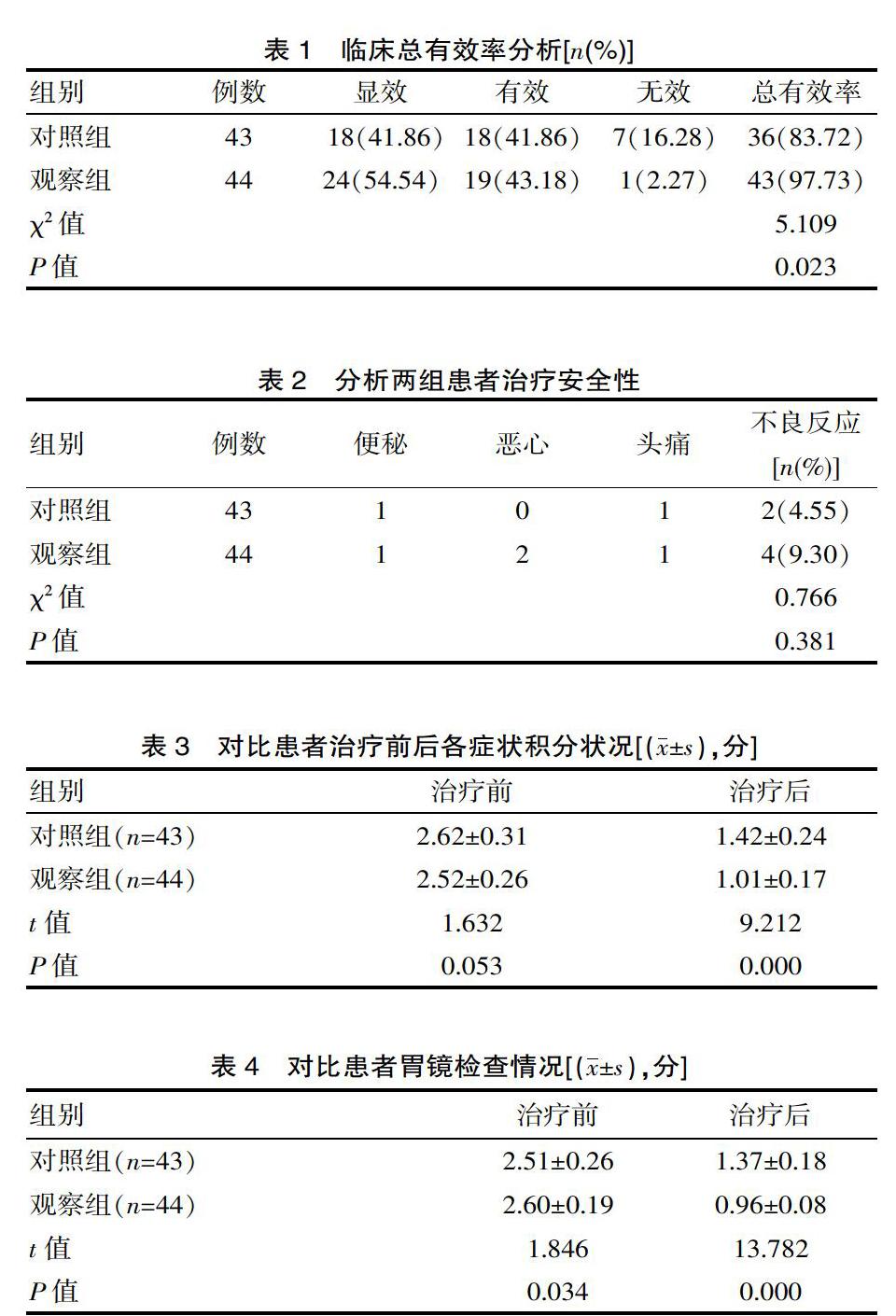胃食管反流病给予不同疗程奥美拉唑治疗的对比分析
苏德云

[摘要] 目的 分析胃食管反流病給予不同疗程奥美拉唑治疗的对比。方法 方便选取2017年3月—2018年9月该院收治的胃食管反流患者87例,所有患者均采用奥美拉唑治疗,随机单双数法分为对照组43例治疗4周、观察组44例治疗6周,对比两组患者临床疗效以及安全性和效率。结果 观察组患者临床总有效率97.73%(43/44)显著高于对照组83.72%(36/43),差异有统计学意义(χ2=5.109,P<0.05);观察组患者治疗时并发症率9.30%、对照组4.55%,差异无统计学意义(χ2=0.766,P>0.05);治疗前观察组患者症状积分(2.62±0.31)分和对照组(2.52±0.26)分比无较大差异,且差异无统计学意义(t=1.632,P>0.05);治疗后发现观察组反酸、烧心等症状积分(1.01±0.17)分和对照组比(1.42±0.24)分更少,差异有统计学意义(t=9.212,P<0.05);胃镜检查下治疗前效果较差,数据无统计学意义(t=1.846,P>0.05);观察组治疗后胃镜检查状况(0.96±0.08)分低于对照组(1.37±0.18)分,差异有统计学意义(t=13.782,P<0.05)。结论 胃食管反流采用奥美拉唑治疗6周后,患者临床疗效更高,不良反应少、症状计分和胃镜检查均更优。
[关键词] 胃食管反流病;奥美拉唑;疗程;症状积分;黏膜发红
[中图分类号] R571 [文献标识码] A [文章编号] 1674-0742(2019)05(c)-0131-03
[Abstract] Objective To analyze the comparison of different courses of omeprazole in the treatment of gastroesophageal reflux disease. Methods Convenient select from March 2017 to September 2018, 87 patients with gastroesophageal reflux disease were treated in our hospital. All patients were treated with omeprazole. The patients were randomly divided into the control group and 43 patients for 4 weeks. The observation group of 44 patients were treated for 6 weeks, and the clinical efficacy, safety and efficiency of the two groups were compared. Results The total clinical effective rate of the observation group was 97.73% (43/44), which was significantly higher than that of the control group 83.72%, (36/43). The difference was statistically significant (χ2=5.109, P<0.05). The rate was 9.30% and the control group was 4.55%. The difference was not statistically significant (χ2=0.766, P>0.05). There was no significant difference between the symptom score (2.62±0.31)points and the control group (2.52±0.26)points in the observation group before treatment. The difference was not statistically significant (t=1.632, P>0.05). After treatment, the symptom scores of acid reflux and heartburn (1.01±0.17)points and control group (1.42±0.24)points were less. The difference was statistically significant(t=9.212, P<0.05); the effect before gastroscopy was poor, the data were not statistically significant (t=1.846, P>0.05); the observation group was less than (0.96±0.08)points after treatment. The control group (1.37±0.18)points was statistically significant (t=13.782, P<0.05). Conclusion Gastroesophageal reflux after 6 weeks of treatment with omeprazole has higher clinical efficacy, less adverse reactions, better symptom scores and gastroscopy.

